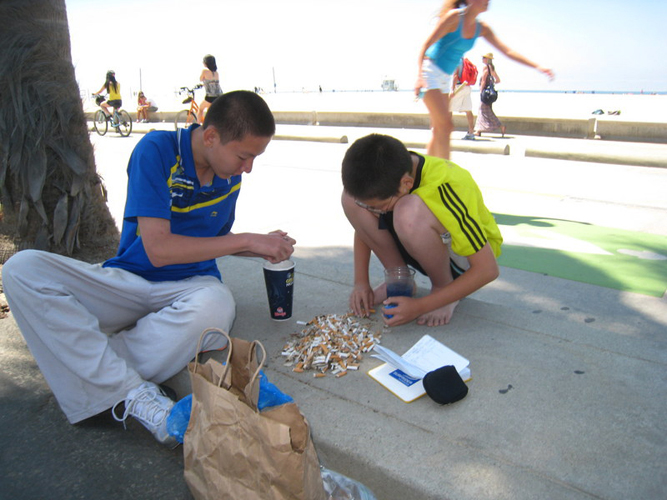
SM BEACH — Chinese exchange students led by Santa Monica High School instructor and scientist Benjamin Kay found a "community ashtray" polluting the boardwalk in Santa Monica.
Twenty-six Chinese middle and high schoolers participated in the new Splash into Science five-day intensive environmental science program starting Aug. 1 that culminated with group research projects — one of which aimed to count and collect littered cigarette butts around the Santa Monica Pier and boardwalk.
Of the three zones studied, a team of eight middle schoolers found a 1-meter-wide strip of sand adjacent to the beach boardwalk between the pier and the Casa Del Mar hotel to be a key pollution area, containing five to eight times more butts than the equivalent spatial area of the boardwalk itself.
The Santa Monica Municipal Code prohibits smoking in any public beach or park. Though Kay was relieved that his students found fewer butts closer to the beach, he was disturbed at the boardwalk results and cited foot-traffic and tourists as a potential cause.
In the residential area around the beach, the multi-unit building at 229 Bicknell Ave. held the residential record of 77 butts, 97 percent of which were found on the street within 1 meter of the curb. Kay speculated that ever since passage of the 2012 law prohibiting smoking in newly occupied apartments and condominiums, residents tend to smoke outside on the curb and dispose of their cigarette butts then and there.
One of the study's recommendations called for a discussion with city officials on adding more trash receptacles in residential areas, even along the boardwalk, to reduce the risk of littered butts, especially considering how slowly it takes for them to biodegrade before they get washed out into drains and the ocean during rainfalls.
Adam Radinsky, head of Santa Monica's Consumer Protection Unit, said that if more public receptacles were to be on the table for discussion it would have to be a case for the City Council to deliberate and more studies would have to be conducted before making any conclusions, Radinsky said.
He added that Santa Monica has a history of leading the charge in protecting residents from the dangers of second-hand smoking, evidenced by City Hall being one of the first to enforce the state labor code law against smoking in bars and restaurants in 1998.
Even with a dedication to healthier air and clean streets, Board of Education member Ben Allen — who introduced Kay to Sunny Cheng, founder and owner of Sunny International Exchange Inc., that brought the students to the U.S. — was still dismayed at the small-scale study's results, adding that he felt embarrassed the students had to see how dirty the environmentally-minded Santa Monica could get.
"I don't understand why people who would never throw a piece of paper on the ground would throw a cigarette on the street," Allen said.
Looking ahead, Kay hopes members of his Team Marine program at Samohi that helped with the Splash into Science program will take interest in the results and pursue the study further.
Cheng and Kay plan to offer the summer intensive program again to Chinese students next year, though somewhere down the road Kay would hope to expand its reach to other countries.
Though international exchange programs have taken place in Santa Monica before, Kay noted this was the first time it was based specifically on exposing youth to the study of environmental science. It was also the first time he had worked with a younger age group.
"I haven't worked much with middle schoolers but I admired their work ethic," Kay said.
Other instructors included Samohi teacher Ingo Gaida and marine scientist and founder of Get Inspired Inc., Nancy Caruso.
Cheng said that through the overall examples set by their instructors, the students were able to form commendable and sustainable habits, such as reduce, reuse and recycle.
"These habits will be passed on to the students' families and friends when they return to China. It is meaningful for their future," Cheng wrote in an e-mail.
Though conversations on starting the Splash into Science program took place less than two months before the students arrived, Kay felt the pilot still set a good bar for future years.
"You can call it beginner's luck," Kay said.
editor@www.smdp.com









